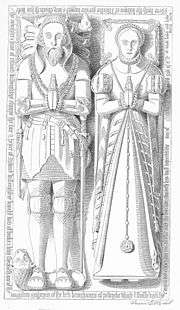Elizabeth Willoughby, 3rd Baroness Willoughby de Broke
| Elizabeth Willoughby | |
|---|---|
|
Effigies of Sir Fulke Greville and Elizabeth Willoughby, Alcester Church, Warwickshire.[lower-alpha 1] | |
| Spouse(s) | Sir Fulke Greville |
|
Issue
Sir Fulke Greville Robert Greville Sir Edward Greville Mary Greville Eleanor Greville Katherine Greville Blanche Greville Four other daughters | |
| Noble family | Willoughby |
| Father | Edward Willoughby |
| Mother | Margaret Neville |
| Born | c.1512 |
| Buried |
15 November 1562 Alcester, Warwickshire |
Elizabeth Willoughby, 3rd Baroness Willoughby de Broke, de jure 11th Baroness Latimer (c.1512 – c. 15 November 1562) was an English noblewoman and wife of Sir Fulke Greville.
Life
Elizabeth Willoughby was the eldest daughter of Edward Willoughby of Alcester, Warwickshire, and Powick, and Margaret Neville, daughter of Anne Stafford and Edward Neville. Elizabeth's father, Edward Willoughby, died in November 1517, leaving Elizabeth still a minor. Her wardship was acquired in 1522 by Sir Edward Greville of Milcote, Warwickshire.[1] At her grandfather's death on 11 November 1521, the baronies of Willoughby de Broke and Latimer fell into abeyance between his three granddaughters; all daughters of his son Edward; Elizabeth, Anne and Blanche.[2] The barony was settled on Elizabeth after Anne and Blanche died childless.[2]
Shortly before 11 April 1526 Sir Edward Greville married his ward Elizabeth to his second son, Sir Fulke Greville (bef. 1505–10 November 1559) of Beauchamps Court, Alcester.[3] He did so because Elizabeth preferred Fulk over his older brother.[4] A manuscript dated 1644 entitled The Genealogie, Life and Death of Robert, Lord Brooke, then in the possession of the Earl of Warwick, describes their courtship:
| “ | In the days of Henry VIII, I read of Sir Edward Greville, of Milcote, who had the wardenship of Elizabeth, one of the daus. of the Lord Brooke's son. The knight made a motion to his ward to be married to John, his eldest son, but she refused, saying that she did like better of Fulke, his 2nd son. He told her that he had no estate of land to maintain her; and that he was in the King's service of warre beyond the seas, and therefore his return was very doubtful. Shee replied and said, that shee had an estate sufficient both for him and herself, and that she would pray for his safety and wait for his coming. Upon his return home, for the worthy services he had performed, he was by King Henry honoured with a knighthood; and then married Elizabeth, the dau. of the Lord Brooke's son.[5] | ” |
In 1542/3 Elizabeth's husband, Fulke Greville, was knighted by Henry VIII for military service to the crown. He was High Sheriff of Warwickshire in 1543 and a member of Parliament from 1547.[6] He further distinguished himself along with forty men in the suppression of the Pilgrimage of Grace and served in campaigns in 1544 against France.[3] He built his wife and family a new house at Beauchamp's Court with stone reclaimed from Alcester Priory.[3] Fulk died on 10 Nov 1559.[3] Elizabeth died 9 November 1562 and was buried beside her husband with a monumental inscription.[3]
At her death the title passed to her eldest son, Fulke Greville, 4th Baron Willoughby de Broke.[5]
Family
Elizabeth Willoughby and Sir Fulke Greville had seven sons and eight daughters[3] among whom were:
- Fulke Greville, 4th Baron Willoughby de Broke.[5]
- Robert Greville
- Sir Edward Greville, who married Jane Grey.[7]
- Mary Greville, who married William Harris.
- Eleanor Greville, who married Sir John Conway.
- Katherine Greville (d.1611), who married Giles Reade (d.1611), esquire, of Tewkesbury, Gloucestershire, by whom she had thirteen children.
- Blanche Greville.
- Five additional sons
- Four other daughters
Ancestry
| Ancestors of Elizabeth Willoughby, 3rd Baroness Willoughby de Broke | |||||||||||||||||||||||||||||||||||||||||||||||||||||||||||||||||||||||||||||||||||||||||||||||||||||||||||||||||||||||||||||||||||||||||||||||||||||||||||||||||||||||||||||||||||||||||||||||||||||||||||||||||||||||||||||||||||||||||||||||||||||||||||||||||||||||||||||||||||||||||||||||||||||||||||||||||||||||||||||||||||||||||||||||||||||||||||||||||||||||||||||||||||||||||||||||||||||||||||||||||||||||||||||||||||||||||||||||||||||||||||||||||||||||||||||||||||||||||||||||||
|---|---|---|---|---|---|---|---|---|---|---|---|---|---|---|---|---|---|---|---|---|---|---|---|---|---|---|---|---|---|---|---|---|---|---|---|---|---|---|---|---|---|---|---|---|---|---|---|---|---|---|---|---|---|---|---|---|---|---|---|---|---|---|---|---|---|---|---|---|---|---|---|---|---|---|---|---|---|---|---|---|---|---|---|---|---|---|---|---|---|---|---|---|---|---|---|---|---|---|---|---|---|---|---|---|---|---|---|---|---|---|---|---|---|---|---|---|---|---|---|---|---|---|---|---|---|---|---|---|---|---|---|---|---|---|---|---|---|---|---|---|---|---|---|---|---|---|---|---|---|---|---|---|---|---|---|---|---|---|---|---|---|---|---|---|---|---|---|---|---|---|---|---|---|---|---|---|---|---|---|---|---|---|---|---|---|---|---|---|---|---|---|---|---|---|---|---|---|---|---|---|---|---|---|---|---|---|---|---|---|---|---|---|---|---|---|---|---|---|---|---|---|---|---|---|---|---|---|---|---|---|---|---|---|---|---|---|---|---|---|---|---|---|---|---|---|---|---|---|---|---|---|---|---|---|---|---|---|---|---|---|---|---|---|---|---|---|---|---|---|---|---|---|---|---|---|---|---|---|---|---|---|---|---|---|---|---|---|---|---|---|---|---|---|---|---|---|---|---|---|---|---|---|---|---|---|---|---|---|---|---|---|---|---|---|---|---|---|---|---|---|---|---|---|---|---|---|---|---|---|---|---|---|---|---|---|---|---|---|---|---|---|---|---|---|---|---|---|---|---|---|---|---|---|---|---|---|---|---|---|---|---|---|---|---|---|---|---|---|---|---|---|---|---|---|---|---|---|---|---|---|---|---|---|---|---|---|---|---|---|---|---|---|---|---|---|---|---|---|---|---|---|---|---|---|---|---|---|---|---|---|---|---|---|---|---|---|---|---|---|---|---|---|---|---|---|---|---|---|---|---|---|---|---|---|---|---|---|---|---|---|---|---|---|---|---|---|---|---|---|---|---|---|---|---|---|---|---|---|---|---|---|---|---|---|---|---|---|---|---|---|---|---|---|---|---|---|---|---|---|---|---|
Faris, Plantagenet Ancestry (NEHGS, 1999), pp. 40-1, 208-09, 216 | |||||||||||||||||||||||||||||||||||||||||||||||||||||||||||||||||||||||||||||||||||||||||||||||||||||||||||||||||||||||||||||||||||||||||||||||||||||||||||||||||||||||||||||||||||||||||||||||||||||||||||||||||||||||||||||||||||||||||||||||||||||||||||||||||||||||||||||||||||||||||||||||||||||||||||||||||||||||||||||||||||||||||||||||||||||||||||||||||||||||||||||||||||||||||||||||||||||||||||||||||||||||||||||||||||||||||||||||||||||||||||||||||||||||||||||||||||||||||||||||||
Notes
- ↑ Inscription in ledger-line: "Here lyeth the bodyes of s. ffoulke grevile knyght & lady Elizabeth his wefe the doughter & heire of edward willoughbye esquyre the sone & heyre of Robert willoughbye knyght lord of broke & lady Elizabeth one of the doughters & coheyres of the lord beauchamps of powycke whiche s ffoulke dyed the x day of november a'no d'ni M.o d.o lix and the seid lady Elizabeth hys wyff deperted the ...day of...in the yere of o.r lord god M.o d.o lx of whose soules god have mercy amen". Drawn by Roscoe Gibbs, 1890.
References
- ↑ George E Cokayne, The Complete Peerage of England, Scotland, Ireland, Great Britain, and the United Kingdom, Extant, Extinct, or Dormant, Vol. XIII (London: George Bell & Sons, 1898), p. 150
- 1 2 George E Cokayne, The Complete Peerage of England, Scotland, Ireland, Great Britain, and the United Kingdom, Extant, Extinct, or Dormant, Vol. XIII (London: George Bell & Sons, 1898), p. 150, note (h)
- 1 2 3 4 5 6 David Faris, Plantagenet Ancestry of Seventeenth-Century Colonists, Second Edition (Boston: NEHGS, 1999), p. 41
- ↑ Barbara J. Harris, English aristocratic women, 1450-1550 : marriage and family, property and careers (Oxford: Oxford University Press, 2002), p. 56
- 1 2 3 Burke's Genealogical and Heraldic History of the Peerage, Baronetage and Knightage, 103rd Edition, ed. Peter Townend, (London: Burke's Peerage Limited, 1963) p. 2509.
- ↑ Burke's Genealogical and Heraldic History of the Peerage, Baronetage and Knightage, 103rd Edition, ed. Peter Townend, (London: Burke's Peerage Limited, 1963) p. 2508.
- ↑ David Faris, Plantagenet Ancestry of Seventeenth-Century Colonists, Second Edition (Boston: NEHGS, 1999), pp. 41, 161
External links
| Peerage of England | ||
|---|---|---|
| Preceded by Robert Willoughby |
Baroness Willoughby de Broke 1536-1562 |
Succeeded by Fulke Greville |
